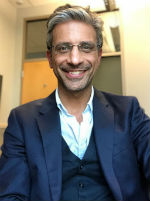|
In This Issue...
- Opioid Crisis
- Neuroscience is a Popular Science and for a Good Reason
- Being Inspired to Be
- Meet the 2018 IBNS Keynote Speakers
- Trending Science
- Join IBNS on Florida's Coast in Boca Raton!
Join us for the IBNS 27th Annual Meeting in beautiful Boca Raton, Florida, USA at the Boca Raton Resort from June 27-July 2, 2018! For more information, please visit IBNS 2018 Annual Meeting and feel free to contact the IBNS Central Office with any questions.
Opioid Crisis
by Davide Amato, PhD, Editor-in-Chief
Medical Science of South Carolina, Charleston, SC, USA
 U.S. national figures show that nearly 100 people die from overdoses every day due to opioids overdose. In most of these cases, opioids were initially prescribed for treating pain. U.S. national figures show that nearly 100 people die from overdoses every day due to opioids overdose. In most of these cases, opioids were initially prescribed for treating pain.
According to TIME magazine, drug overdoses claimed more lives in 2015 than car accidents and gun violence, and matched the HIV/AIDS crisis at its peak, bringing its phenomena to the equivalence of a new 9/11 attack every three weeks (according to governative sources).
Touched by these numbers, we decided to dedicate this issue of our IBNS News to the opioid crisis. To this purpose, we interviewed two experts in the field from the Medical University of South Carolina (MUSC), Dr. Kathleen T. Brady, Distinguished Professor and Vice President for Research, and Dr. Brett Froeliger, Associate Professor in Neuroscience. Additionally, we report the story of a brilliant young woman and researcher at the MUSC who knows a lot about the pharmacology of opioids -- not just because she learnt it from her work, but also because she needs opioid-based treatments to relieve the chronic pain of which she is afflicted.
 Rachel Penrod-Martin, Ph.D. Rachel Penrod-Martin, Ph.D.
Post Doctoral Scholar, Medical University of South Carolina
Hi Rachel, would you like to tell us more about your medical condition?
As a person with chronic pain, balancing treatment against the risks of treatment is forefront in my mind. During graduate school and post-doc, I had a series of herniated discs that have required guided injections, physical therapy, and even hospitalization. Even with intervention, I am left with persistent neuropathy due to damage of my sciatic nerve. With every flare-up, I return to a cocktail of medicines including anti-inflammatories, muscle relaxants/anti-spasmodics, and opioid painkillers.
When locked in a period of daily pain, it becomes this all-encompassing phenomenon. Everything I do is an attempt to manage (or avoid exacerbating) my pain. The clothes I wear, the activities I do, how I sit/stand. It is noticeable, it is distracting, and it still doesn't really help all that much. There is a joke among my friends about my "flamingo-ing," a posture where I lift my right leg off the ground in attempt to reduce pain in my lower back, hips, and knees. It's a silly descriptor, but a powerful cue to those around me that I'm in rough shape. Although this, and other tricks, can reduce the acute exacerbation of pain, they aren't sufficient to actually treat it.
The opioids really do help, particularly with the psychological effects of near-constant pain. When I'm in a period of daily, seemingly unceasing pain, opioids are the best option to improve my quality of life. NSAIDs and muscle relaxants have a big place in my longer-term treatment plan, but they aren't nearly as powerful to treat my pain in short-term. I say opioids help with the psychological effects, for me that is because having a break from the pain (or at least a reduced awareness of it) helps me from feeling hopeless or frustrated with the situation. It is incredibly frustrating and demoralizing to feel helpless about uncontrolled pain, the little break that opioids can provide from that is renewing, restoring, and really needed.
Are you aware of the risks for addiction linked to opioid drugs consumption?
There are two major risks I associate with needing these drugs. The first is clearly their high addictive liability, but the second is that I won't be able to get them when I really need them. The balancing of these risks means I'm often not treating my pain as efficaciously as I could be, and my quality of life can suffer from that.
The stigma associated with needing these drugs is intense, and feeling like a "drug seeker" is really uncomfortable. While my medical history has ample evidence for chronic pain (be it from acute herniation, lasting neuropathy, or seemingly unrelated fibromyalgia like pain in other joints), I still feel like I can't ask.
I am not addicted to opioids and I take steps to avoid this. I never take them unless the situation really requires it. As a neuropharmacologist, I have "inside" knowledge of these drugs, and I try to select my treatment based on what I think is the minimal opioid required. During the day, I will tolerate a fair bit of pain. I'll manage with ice packs, postural changes, and NSAIDs. Rarely will I use an opioid during the day and if so, I use something lower strength like tramadol. At night is when I'm most likely to treat pain with an opiate. Enough pain (be it intensity or duration) will make me less likely to eat, I won't be able to fall asleep or stay asleep; this is when I use something stronger, usually a low dose of oxycodone.
When I am in acute pain exacerbation, it makes the decision to treat with opiates easier to make. During this phase, most physicians will prescribe them and encourage their use. I'm usually in PT and seeing Pain Management so everyone knows how much I have/need/use. There are also periods where I have little to no pain and I'm not using anything. The tricky times are the in between periods: where I have unexpected pain, flare-ups, or I can't get ahead of the problem before it gets worse. These are the times where I agonize about treating my pain. "Is it really bad enough?" - this is the question that defines the "razors edge" for me. If it isn't bad enough, and I take stronger opiates than I need, I am making myself vulnerable to abuse. If it is bad enough but I don't take opiates, I risk allowing the pain to perpetuate and often get worse.
I don't think I've ever experienced a real opiate "high." For me, the relief of pain is pretty euphoric, but nowhere near as intense how I hear people describe the high. This is how I protect myself from addiction. My goal is never just to feel good due to the drug. "Is this really bad enough" makes me seek out every treatment before I turn to opiates. Do I spend more time in pain than I absolutely have to? Yes, absolutely. And it stinks. Do I feel like under-treating keep me safe? Yes, that's why I do it.
I do think I've experienced an opiate withdrawal, and it made it clear to me why it is so hard for people to stop taking them. I had been hospitalized for ~72 hours following a particularly dangerous herniation. In addition to epidural steroids and anti-inflammatories, I was on a Dilaudid drip for pain. This was wonderful the first few days; it left me foggy, but I didn't hurt at all. I was the happiest I had been in weeks, probably because I was actually receiving consistent opiate administration. Consistent and physician supervised, the best possible scenario. At the end of that period, I was nearing the time to leave the hospital. My Dilaudid drip was removed and I was placed on oral oxycontin. While oxycontin is a stronger opiate than hydromorphone (Dilaudid), the difference between a consistent IV delivery and an oral delivery every four hours was very noticeable. Within a few hours of the drip being removed, I was miserable: angry, sweaty, aches all over, nauseated. It was terrible. Luckily for me, this only lasted a handful of hours. As the oxycontin came on board, my withdrawal symptoms quickly dissipated. Maybe I've never felt the high, but I can easily see how withdrawal would be enough to keep people using.
What do you think makes you different than other people who develop drug addiction consequently to opioids consumption?
I am really fixated on the risk of these drugs and I take specific action to mitigate that risk. My husband and I talk frequently and openly about the risk, and he serves as a good balance to me. He also asks, "Is it worth it?," but he can see when I'm in pain and will push if he disagrees with my assessment. My coworkers and friends also know about my pain and they do little things all the tie to help protect me fro the risk of pain. I can't remember the last time I picked something up off the floor! The social support, the awareness of risk, and the choice that I'd rather under-treat than take too much.
Based on your personal experience as an opioids consumer (for therapy reasons) and trainee in Addiction Neuroscience, do you ever feel like giving suggestions to other colleagues or experts in the field?
Let's make better drugs! I think designing drugs that can synergize, targeting multiple pain systems at once, allowing for lower doses of the opiate are key.
We can't get rid of these medications. They are incredibly efficacious and they improve the quality of life for many users. Maybe if patients were engaged in the "Is it worth it?" dialogue with their caregivers and prescribers?
It might be time for some new ideas for drugs and treatments. Our hands have been tied for so long from researching cannabinoids, but clearly there are possible applications, could this be the thing we need? I like yoga, meditation, and exercising in the water -- pain patients are routinely told that increased activity will improve their symptoms, but creating classes specifically for pain might help more people to be involved. I know I'm always wary of a new activity, as you never know what can trigger your pain.
Overall, would you say that the treatment with opioids manages to give your life some sort of happiness?
I'm not happy with my pain, but I'm happy with my life. I've had enough kinds of treatments that I do know what works for me, a leg up on many chronic pain sufferers. I have great insurance and have never been unable to get the treatment I need. It is sad to know that there are people with worse pain than mind that don't have access to treatment or alternatives to opiates. I hope in the future this doesn't have to be a concern for people.
Are there any thoughts that you would like to share with the IBNS readers?
I think it would be really interesting to hear more about the current research on mechanisms of pain and chronic pain, drug development, and epidemiology. We all know that opiate addiction is a problem right now but most neuroscientists don't study the medical usage of the drugs and processes related to them. Generating this kind of information, particularly for the public, might encourage discussion and advocacy for new treatments.
 Kathleen T. Brady, MD, Ph.D. Kathleen T. Brady, MD, Ph.D.
Distinguished University Professor and Vice President for Research, Medical University of South Carolina
Dr. Brady, what is your opinion regarding the devastating impact of opioid drugs on general human health and society?
Many opioids are natural substances that have been used safely by humans for pain relief for hundreds of years. Opioids are very effective at providing short-term pain relief and their use has made many surgical procedures, post-operative periods, as well as other acute injuries much more manageable. The problem is that opioids do have several "down sides." People develop tolerance to opioids quickly which means they need to continue to increase their dosage to achieve the same therapeutic effect. This is one reason why opioids are not an optimal choice for people with chronic pain conditions. In addition, opioids generally have a narrow therapeutic index, which means that the dose required to suppress the respiratory drive can be close to the dose that produces analgesia. Particularly, as a person becomes tolerant to the pain relief and euphoria produced by the opioid, they may increase their dose to improve the pain-relieving qualities. This is a dangerous situation as individuals can get dangerously close to the dose of opioid that causes respiratory depression; which is most often the cause of death in opioid overdose. In addition, opioids produce euphoria, a sense of well-being, that has serious abuse potential and can produce addiction.
In recent years, a few issues have converged to lead to the increased problematic use of opioids and opioid overdose. Pain is a common complaint of people visiting primary care doctors - as managed care has forced shorter patient care visits, a medication can be a quick and easy way to manage pain. In addition, many payment and accreditation systems encouraged practitioners to be aggressive in the treatment of pain by talking about pain as the "fifth" vital sign. In addition, new opioids were marketed to practitioners with the claim that they had less abuse potential. This claim was unfounded and these new opioids, oxycontin products, actually had an increased abuse potential. So there were a number of pressures on practitioners in the U.S. and prescribing opioids regularly and inappropriately (i.e. for chronic, non-cancer pain) became commonplace. As the problem became apparent, there have been educational and regulatory pressures on practitioners and opioid prescriptions have actually decreased over the last several years. Unfortunately, the demand created by the earlier, more liberal prescribing of opioids opened up an illicit opioid market; so as prescription drugs have become less accessible, illicit, and high potency, very dangerous opioids have entered the U.S. market. The lethal overdose potential of drugs like fentanyl, carfentanyl, and other high potency illicit opioids that have flooded the U.S. illicit drug market, is much higher than that of prescription drugs.
Do we really need opioids to treat pain? What about other medicines with an alternative mechanism of action, are they better?
Pain is a symptom, not a disease. There are many different medical diseases and conditions that are associated with pain, and the best treatment for pain depends on the cause of the pain. Opioids are excellent for short-term treatment for severe pain. Other pain relievers (such as aspirin, ibuprofen, and acetaminophen) relieve minor pain through different mechanisms, such as blocking inflammatory pathways. There are also pain relievers that are best for neuropathic pain. So opioids are definitely good medications for certain types of pain, but each pain condition should be evaluated for the most appropriate treatment. Opioids are not the best treatment for many types of pain, and further research focused on innovative, non-addictive treatments for pain is needed.
Would you like to share a few simple words on how opioids can tackle pain; and at the same time, trigger such a strong addiction?
In addition to having actions to blunt the pain pathways in the brain, opioids also act on the pleasure pathways in the brain to produce euphoria. Efforts in drug development focused on separating these two actions (i.e. making an opioid that would give pain relief without producing euphoria) have not been successful. However, just because a drug produces pleasure, doesn't mean that everyone who takes the drug will become addicted. There are genetic, environmental, and interpersonal risk factors for addiction. Also, addiction is most likely when there is a combination of exposure/access to an addictive drug at a time when an individual is vulnerable to the development of addiction.
Do you think that a better understanding of the action mechanism of opioids could help clinicians to control effectively the separation of the therapeutic effects from the unwanted side-effects (i.e. dependence)?
As mentioned above, there has been a fair amount of research focused on trying to seperate the pain-relieving effects of opioids from the euphoria produced by opioids. Unfortunately, these efforts have not been successful to date. However, exploration of alternative strategies, both pharmacologic and non-pharmacologic, for the management of pain are being widely pursued. For example, there are a number of studies using brain stimulation methods to control pain. There are also studies of mindfulness meditation, cognitive-behavioral strategies, and acupuncture. In addition, non-opioid agents with different mechanisms of actions are also under exploration.
What do you think is going to be the future of opioids as medication tools in America, and what is going to be the future for pain treatment?
American medical providers are becoming much more cautious about using opioids. A number of initiatives are being in place to encourage more responsible prescribing. Prescription drug monitoring programs are in place in every state so a physician can see, in real time, whether a patient is getting opioids from another prescriber or if they are receiving a combination of drugs that could be life-threatening. Continuing medical education initiatives focused on opioid prescribing and pain management have proliferated, and many states are requiring physicians to participate. In addition, many specialties are publishing practice guidelines for the use of opiates in certain clinical situations; such as post-operative pain, dental surgery, sickle cell crisis, etc. In addition, the opioid crisis has spurred an increase in research on alternative methods for management of pain. So, while I think there will continue to be a place for opioids in the management of pain in the U.S. healthcare system, I think their use will be much more limited than it has been over the past ten years.
 Brett Froeliger, Ph.D. Brett Froeliger, Ph.D.
Associate Professor, Medical University of South Carolina
Dr. Froeliger, what is your research about?
The overarching goal of my research program is to better understand and characterize mechanisms that underlie drug addiction. Human neuroimaging is one method, or tool, that helps us to better understand the biological basis of addiction and thus, by doing so, translate between preclinical and clinical sciences. My lab utilizes neuroimaging to examine the effects of novel medications and behavioral interventions on the brain and evaluate associations between treatment-related neural outcomes and clinical outcomes.
You are an expert in action mechanisms of addictive substances, as we learn it from your studies with imaging fMRI. According to your experience, if we keep the genetic and the environmental factors that affect pharmacological responses out of the discussion, do you think it would be possible to imaging different brain structures that mediate antinociception, reward, and the pathological seeking of opioids?
Researchers across the world have been using functional magnetic resonance imaging (fMRI) and position emission tomography (PET) to obtain in vivo measurements of neuroanatomical, functional, and metabolic processes under-girding the maintenance of substance use disorders -- including Opioid Use Disorder. Though it is possible to examine structure and function that mediates interoception, nociception and reward processes, there are a number of important factors that need to be considered. Long-term opioid use often co-occurs with pain and thus, it is important to consider pain symptoms and response to pain among this population. Another important consideration is polysubstance abuse. Often is the case where individuals who meet criteria for Substance Use Disorder for one psychoactive substance, also meets criteria for SUD for another e.g. alcohol, tobacco. Though it may be difficult to disentangle the effects associated with each condition, it is extremely important to design experiments that measure co-morbid factors.
Neuroscience is a Popular Science and for a Good Reason
by Davide Amato, PhD, Editor-in-Chief
Medical Science of South Carolina, Charleston, SC, USA
A recent bibliometric study conducted, by Yeung et al. 2017 and published in Frontiers Neuroscience, reveals the growing popularity of the research in Neuroscience; especially in psychology and and behavioral sciences around the globe.
As I have recently taken a new job in the Neuroscience Department at the Medical University of South Carolina, and among many scientific activities, I had the fantastic opportunity to teach Behavioral Neuroscience for the Psychology Department at College of Charleston. There, I leaped into the opportunity to pose the following, very simple question: Why did you decide to study neuroscience?
I heard a variety of interesting reasons. To honor the effort in volunteering with this task, I decided to publish the answer of one of my students because it summarizes it all, and importantly because it reflects noble reasons why people would engage in studying neuroscience. Ms. Hannah Farmer, the author of this piece, expressed her thoughts in a poetic way and we appreciated that!
Being Inspired to Be
by Hannah Farmer
College of Charleston, Charleston, SC, USA and trainee at the Medical University of South Carolina
What is it about the human brain, the organ suspended inside our skulls, greedily consuming nearly a fourth of the energy we intake, which fascinates us perpetually? We began to wonder back in the ancient Egyptian era, and have continued to ponder ever since. We now have vast fields of study devoted wholly to piecing together the mystery of the brain, trying to find answers to questions that are hardly tangible enough to ask. So what keeps us curious?
I became fixated before I was really aware of what the root of my fascination was. My little brother, Trey, was born with profound sensorineural hearing loss, rendering him completely deaf. Trey received his first Cochlear Implant at just six months of age. It was not something which I understood much at the time, being only two. But as I grew older, I began to wonder: How does Trey hear? How do the plastic pieces he wears on his head enable him to translate sound waves to noise? How does the brain know that those novel signals that it's receiving equate to chattering, or a horn honking, or the ocean crashing? If you introduce some random stimulus for the brain, how is it 'smart' enough to know how to sort that stimulus and make sense of it?
My interest augmented during my high school years, where a passionate and overly-qualified AP Psychology teacher introduced me to the labyrinthine world of neuroscience. I chose to do my International Baccalaureate Extended Essay on Cochlear Implant, and how the human brain is able to adjust itself to and make use of a newly introduced stimulus when it has never before received 'sound' signals. Quite frankly, the phenomenon of converting any external, mechanical signal into something that we can 'perceive' and actually 'think' about it hardly fathomable -- and what irony that sentence embodies!
I took a class last semester called Behavioral Neuroscience. It was taught by five different scientists (or researchers) from the Medical University of South Carolina, all of whom are engaged in research on the brain. Out of curiosity and an intense desire to finally see the professional world of neurology first-handedly, I inquired of my teacher in psychopharmacology, Dr. Davide Amato, as to what his research entailed, and whether he was in need of any assistants. I was lucky to catch him at a time of need, and now I am able to simultaneously be a college student and research aide. I am working towards obtaining my college degree while simultaneously engaging in research of a professional who is so passionate about his work on the brain, that he enjoys sharing his knowledge and questions with me.
I am young, yes, and relatively inexperienced. But I am so enthralled to finally find myself on the periphery of the world of the brain. And though I am only in the beginning, I can feel a sense of union with the entirety of the field because of how much mystery still remains.
The other day, as I was wrapping up an afternoon at MUSC, Dr. Amato -- for whom I am currently working on a meta-analysis -- and I were chatting about neurology in general. He mentioned something about how we all had so much left to learn, so much more to uncover in a sense, I was right there with them all. The sense of belonging that I speak of is further manifested in the existence of communities such as the International Behavioral Neuroscience Society, which encourages scientists (and those aspiring to be!) in their communal quest for answers. I am excited to have been introduced to the IBNS alliance of individuals who desire to know, and seek to discover. Neuroscience is such a broad and complex field, and I hope that I will be able to breach the barrier and join the ongoing project of discovering the mechanisms that cause drugs to alter the propensities of neurotransmitters, the pathways that enable my brother to hear, and all the various other marvels of the incredible human brain.
Looking for a new employment opportunity or struggling to find the right candidate? Meet the IBNS Career Center!
One of the biggest challenges for any international scientific society is to provide quality and informative support to its members, whether it is for a new employment opportunity or for finding the right candidate for a new position you opened. The IBNS excels in this area through its online Career Center portal (http://jobs.ibnsconnect.org) through which it provides the right tools for both, job seekers and employers.

The IBNS Career Center portal offers all the standard operational features, such as a thorough search engine by keyword and location, as well as extra services such as a free review of your resume for feedback and a job-posting service for employers. However, what makes the IBNS Career Center stand out in terms of support, is two additional quality features: resources for job seekers & access to a resume bank for employers.
In the Resources section you can have access to a number of articles with valuable tips in resume building, job seeking and communication, from experienced scientists in the field, not only for searching or applying for a position, but also for the interview process. There is also plenty of advice and tips for building your ‘brand’ and your social media presence, which will help you strengthen your image and moving your career to the direction you want.
 In the Resume Bank, potential employers have free access to a large bank of resumes and profiles, which you can customize by introducing filters that apply to your search and create lists of candidates that fulfill your own criteria. In the Resume Bank, potential employers have free access to a large bank of resumes and profiles, which you can customize by introducing filters that apply to your search and create lists of candidates that fulfill your own criteria.
Meet the 2018 IBNS Keynote Speakers
by Patricia B. de la Tremblaye
University of Pittsburgh, Pittsburgh, PA, USA
The 2018 IBNS meeting, which will be held at the Boca Raton Resort in Florida, is filled with workshops, networking events, student activities, 28 Special Symposia, and two poster sessions featuring outstanding researchers from all over the world. If you are not already excited for the 2018 lineup, get to know the remarkable Keynote Speakers -- as they tell us some fascinating and fun facts about their professional journey and current interests.
 Tracy Bale is a Professor in Departments of Pharmacology & Psychiatry at the University of Maryland School of Medicine, where she is also a Director of the Center for Epigenetic Research in Child Health and Brain Development. Tracy Bale is a Professor in Departments of Pharmacology & Psychiatry at the University of Maryland School of Medicine, where she is also a Director of the Center for Epigenetic Research in Child Health and Brain Development.
Dr. Bale's laboratory developed mouse models and translational studies focused on vulnerability to stress, assessing sex-specificity, developmental timing, and epigenetic mechanisms involved in the programming of the brain.
She grew up in Minnesota and has always loved science. "The brain seemed like the ultimate puzzle," she said.
Her professional journey brought her to all corners of the U.S.: from Minnesota (undergraduate) to University of Washington in Seattle, Washington (graduate school), to Salk Institute in La Jolla, California (postdoc), with Wylie Vale, to Philidelphia, Pennsylvania (Professor), and to Baltimore, Maryland (Professor/Center Director). Living in the inner harbor of Baltimore, she walks everywhere and uses her Vespa to go to work. "A big change from commuting into Philly," she said. Although, she misses her "morning NPR time," she added. Dr. Bale has access to great views of the water from her home, but her favorite destination stems from a recent trip to Corsica with her husband, Scott Thompson. "[Corsica] is a gorgeous island with beautiful mountains and beaches, and fabulous food and wine," she said.
Dr. Bale's advice for trainees is to, "dive in, think outside the box, and be creative."
 Jill Becker is a Professor in Departments of Psychology and Psychiatry at the University of Michigan. Dr. Becker has been one of the pioneers in the field of sex differences in brain and behavior, ever since she accidentally found that there were sex differences in the striatum -- an area of the brain she has included as a control. Her research elegantly demonstrates that there are sex differences in the neural systems mediating motivation and addiction. Jill Becker is a Professor in Departments of Psychology and Psychiatry at the University of Michigan. Dr. Becker has been one of the pioneers in the field of sex differences in brain and behavior, ever since she accidentally found that there were sex differences in the striatum -- an area of the brain she has included as a control. Her research elegantly demonstrates that there are sex differences in the neural systems mediating motivation and addiction.
Dr. Becker was born in Redwood City, California and grew up in Champaign-Urbana, Illinois. She attended the University of Illinois Laboratory High School (Uni High) -- Jeremy Hobson of NPR's 'Here & Now' is also a Uni graduate.
Dr. Becker studied at the University of Kansas, as an undergraduate in the Department of Human Development. She discovered a love for neuroscience after graduating and never taking a science course. Dr. Becker completed her master's degree at KU while taking a lot of science courses to catch up. She then went to the University of Illinois in Champaign-Urbana to study neuroscience in graduate school. She went to the University of Michigan for a Postdoctoral Fellowship and joined the UM faculty in 1987.
Dr. Becker lives outside of Ann Arbor, Michigan on five peaceful acres of land. In her spare time, Jill likes to ride her Morgan horse named Scout.
 Gregory Quirk is a Professor in the Departments of Psychiatry and Anatomy & Neurobiology, University of Puerto Rico. He is interested in how the brain overcomes fear and how emotional expression is regulated under different circumstances. Gregory Quirk is a Professor in the Departments of Psychiatry and Anatomy & Neurobiology, University of Puerto Rico. He is interested in how the brain overcomes fear and how emotional expression is regulated under different circumstances.
Originally from Connecticut, Dr. Quirk's professional journey started at Northwestern University (undergraduate), and continued at SUNY-Downstate in Brooklyn, New York (graduate school), followed by New York University (postdoc).
Interestingly, while in graduate school, he became involved in political activism, opposing the "Contra" war in Nicaragua; this resulted in making several trips to Central America, which captivated him. After his graduation, he received a Fulbright grant to establish the first neuroscience laboratory in Tegucigalpa, Honduras.
"I drove there with my SUV and studied the effects of malnutrition in the developing brain, in both rats and people," he said. His rewarding experience with the students in Latin America brought him to establish his labs in Puerto Rico at a private medical school (Ponce Health Sci Ctr), before joining the University of Puerto Rico. Twenty years later, he still loves it -- not only for the warm weather and beautiful ocean views in San Juan, but also because "the people, the culture, and the motivated students made it possible to have a very productive and very happy lab," he said.
Dr. Quirk's advice for trainees refers to what kind of research question or type of institution feels right to oneself (not to him over there): "From the Temple of Apollo: 'Know thyself,' if you follow your thoughts and feelings, you are likely to end up with a job that is really you and you'll be effective and motivated. Ignore them at your own peril..."
 Cheryl Sisk is a Professor in the Neuroscience Program and Department of Psychology at Michigan State University. Dr. Sisk’s work resides at the intersection of pubertal hormones, developmental programming of neural circuits, and motivated behaviors, extending to how sex differences arise in brain and behavior. Cheryl Sisk is a Professor in the Neuroscience Program and Department of Psychology at Michigan State University. Dr. Sisk’s work resides at the intersection of pubertal hormones, developmental programming of neural circuits, and motivated behaviors, extending to how sex differences arise in brain and behavior.
Born in Texas and “being both a preacher’s kid and an Army brat (double whammy),” she studied at Baylor University (undergraduate), then at Florida State University (graduate school), followed by Northwestern University (postdoc) and the University of Texas at Austin (postdoc), before taking a faculty position at Michigan State University.
She has been interested in the development of the brain and behavior during puberty and adolescence for virtually her entire career; going from the neurobiology of circadian rhythms, to photoperiodic control of seasonal reproduction, reproductive axis activation (puberty), to reproductive physiology, and neuroendocrine mechanisms. “Eventually, the behavioral neuroscientist in me drew me toward the study of the maturation of social behaviors during puberty and adolescence, and that has kept me fascinated and busy for decades,” she said.
Dr. Sisk has now lived in Michigan for 32+ years and has grown to love the state and the surrounding Great Lakes. “I enjoy spending time in the northwest corner of Michigan, known for its beautiful lakeshores and sand dunes, its cherry, apple, and blueberry orchards, and more recently, its vineyards and wine industry,” she said.
Dr. Sisk’s advice for trainees is to follow their scientific passions, practice critical thinking, and respect the scientific method. “You can take any number of career paths post-PhD in a variety of workforce sectors to make a difference in many, many ways,” she added.
Trending Science
In this column, we share the latest research, interesting scientific articles and news.
by Davide Amato, Editor-in-Chief
Medical University of South Carolina, Charleston, SC, USA
We have long thought that the human brain can generate new neurons during adulthood, and this mechanism can even be triggered through learning processes, aerobic exercises, or as a consequence of the therapeutic effect of antidepressant drugs. Recent evidences showing that no neurogenesis takes place in portions of the hippocampus in adult human brain have weakened this view, according to the journal Nature.
Reference:
Nature. 2018 Mar 15;555(7696):377-381. doi: 10.1038/nature25975.
Human hippocampal neurogenesis drops sharply in children to undetectable levels in adults. Shawn F. Sorrells; Mercedes F. Paredes; , Arantxa Cebrian-Silla; Kadellyn Sandoval; Dashi Qi; Kevin W. Kelley; David James; Simone Mayer; Julia Chang; Kurtis I. Auguste; Edward F. Chang; Antonio J. Gutierrez; Arnold R. Kriegstein; Gary W. Mathern; Michael C. Oldham; Eric J. Huang; Jose; Manuel Garcia-Verdugo; Zhengang Yang; Arturo Alvarez-Buylla.
Join IBNS on Florida's Coast in Boca Raton!
Registration Discounts Offered for the 2018 Annual Meeting
Join the International Behavioral Neuroscience Society for the 27th Annual Meeting which will take place on June 27-July 2, 2018 in Boca Raton -- South Florida's sparkling coast.
Here are a few important dates to take into account if you have not taken action yet:
Exhibitor Registration Deadline: Tuesday, May 1, 2018 at 12:00am
Last Day for Meeting Registration: Friday, June 1, 2018 at 12:00am
Wouldn't you like to save additional discounts on registration fees?
IBNS attendees can receive additional discounts on registration by helping get the word out!
Simply download an IBNS flyer and share it!
Here’s How: print one of our meeting flyers and post it to your department's bulletin board. Then, take a picture of yourself next to the posted flyer and send it to [email protected]. We will send you a discount code for $10 off your registration fee -- the registration form will have the option of applying your discount code on the payment page.
Join IBNS and receive even more discounts!
Don't forget to also share your photo on Facebook, Twitter, and/or Instagram. Be sure to tag us and use the hashtags #IBNSConnect and #IBNS2018.
Remember to "like" and follow IBNS on Facebook, Twitter, and Instagram.

Do you have an interesting hobby or member news to share?
Let us know at [email protected]
|